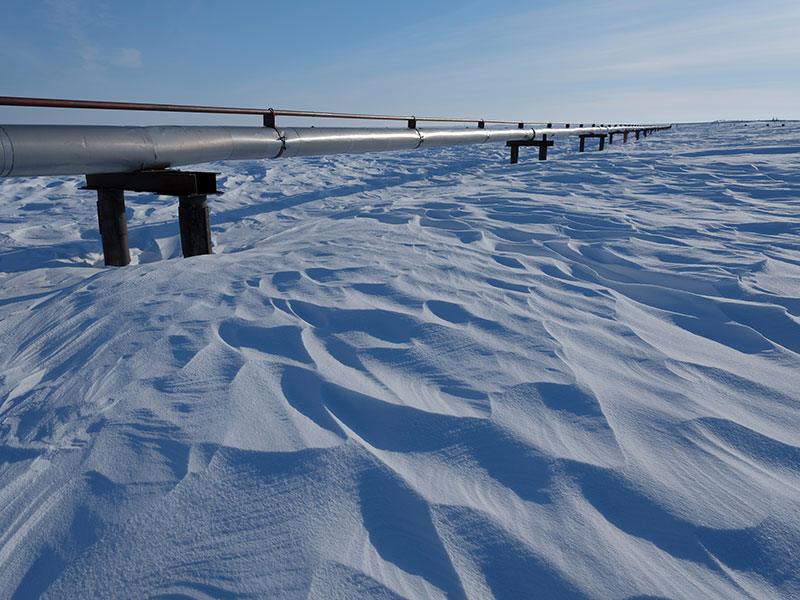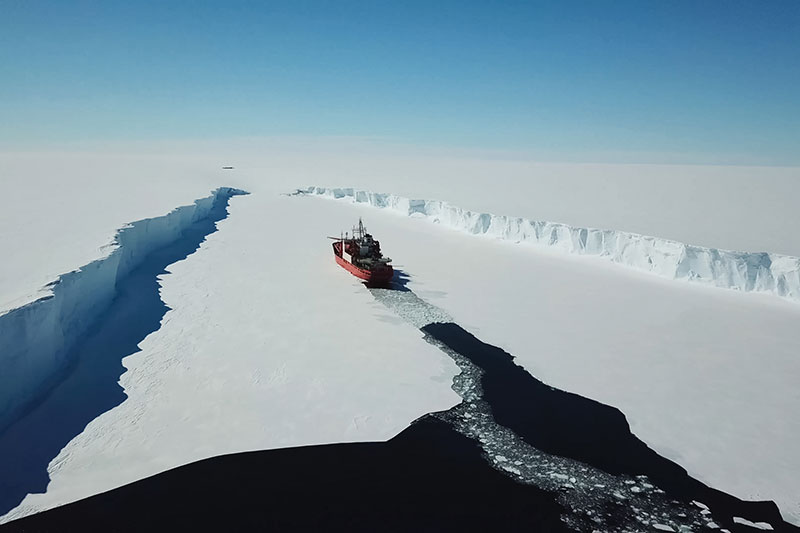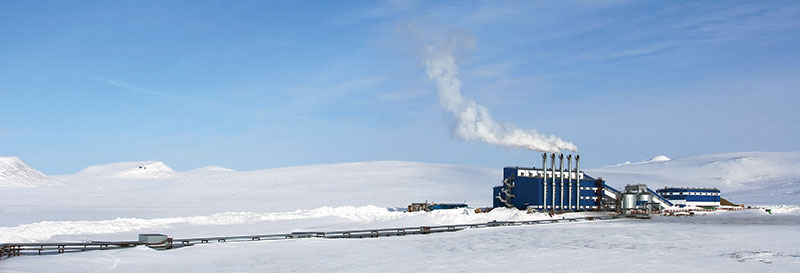December 2021, Vol. 248, No. 12
Features
Part 1: Charting the Arctic’s Hydrocarbon Future
By Gordon Feller, PGJ Contributor
Russia’s government announced, in late July, a sweeping agreement to partner with Dubai’s global transport behemoth, DP World Corp. The goal is to launch a partnership that takes advantage of Arctic warming, which the oil and gas industry says is opening new navigation options and a host of new economic development opportunities.

Russia is not alone in its focus on the Far North. In July of last year, the European Commission launched a public consultation on the way forward for the European Union’s (EU) Arctic policy. In the 12 months since that program began, rising temperatures have taken a huge toll on the ecosystem. What are the prospects in the Far North, and what will the EU do about it?
Climate scientists worry about continued and dramatic Arctic sea ice reductions – with nearly ice-free summer conditions by the mid-21st century. Such reductions will change massive ecosystems, disrupting all life on the planet – both human and non-human.
Global warming is enabling major shifts in marine access, a fact that a growing number of commercial enterprises are looking forward to. Arctic navigation depends on numerous factors besides sea ice, including economics, infrastructure, bathymetry and weather.
Climate change projections are useful for strategic planning by governments, regulatory agencies and the global maritime industry. They are all trying to assess the potential for expanded Arctic marine operations in the coming decades.
The planet’s fast-warming climate brings new opportunities for international transportation networks – and big dangers. Shortening Arctic maritime navigation distances, at least during summer months, will mean more accidents. Opening the Northern Sea Route (NSR) increases the need for new ports and modern infrastructure to service ships that plough through ice-free and ice-covered waters.
Changing Ports
It April of last year, Russia’s ambassador to Denmark, Vladimir Barbin, lobbed an accusation at the US government. He said that the Trump administration was pursuing a “policy of confrontation” in the Arctic region, and it was all being done in a bid to “achieve dominance.” Since the Biden team took office, there has been no change of tune from Moscow.

The global competition for the Arctic is clearly intensifying. One way to understand the unfolding drama is to look at the situation facing Arctic ports. The icy world that these ports have known, since the very first vessels came ashore, is changing much faster than humans had ever expected.
As a result of such a growing complexity of Arctic marine shipping activities, a hierarchical multiplicity of shipping networks has emerged. Arctic shipping arteries are operated by abundant vessels and icebreaker ships, sailing between principal locations behind the Arctic Circle, Europe and Asia, which means that they need to be supported by a well-conducted system of hubs.
Shipping ports are mostly located not far from the city cores – since the main haul activities prevail there in the first place. A supply of labor force, to perform intensive cargo handling activities, is yet another reason for ports to be located close to larger agglomerations.
Arctic hub ports are locating shipping operations in highly accessible places. Because of their direct connections to many key cities, they play a significant role in the development of the Arctic shipping industry.
The new opening of the NSR has had the effect of elevating the importance of Singapore as a global hub, located on the southern end of the Malay in Southeast Asia. The Port of Singapore is the premier world shipping hub because it is situated in a center of a web of trade and connected to more than 600 ports in over 120 countries. As the NSR develops, it will become the Asian gateway into the Arctic.
The Arctic Gateway strategy involves not only the Asian Port of Singapore but also the Canadian Port of Halifax, which is located at a highly strategic point off the Arctic Ocean. The plain aims to develop the Canadian anchorage as an entrance for container traffic sailing into North America via the Arctic Ocean. With the melting ice and extending the Arctic shipping season, it is likely that Halifax will handle Chinese imports transported by rail to Murmansk via Moscow and then shipped over to the northern part of the world.
In temperate maritime areas, deep-water ports (and the services they provide) are typically relatively close to global maritime shipping and often taken for granted. The situation in the Arctic is quite different. Deepwater ports, places of refuge, marine salvage, adequate port reception facilities for ship-generated waste and towing services are rarely available. The availability of port infrastructure and support directly influences the level of risk associated with transiting a particular waterway – and it directly corresponds to the levels of marine insurance rates.
There are few deep-water ports in U.S. or Russian waters near the Bering Strait. The closest U.S. harbor with deep water is Dutch Harbor in the southern Bering Sea. On the Russian Federation side, the nearest deep-water port is Provideniya. Other Russian ports near the Bering Strait that are closed to foreign ships are Egvekinot, Anadyr and Beringovsky.
This situation differs with the region located between the Atlantic and Arctic Oceans, where there are many Norwegian, Icelandic and Russian deep-water ports. Also, there are a number of deep-water ports along the west coast of Greenland.

In the Arctic, there are essentially no deep-water ports along the North Slope of Alaska, or throughout the Canadian Archipelago, except for the port of Tuktoyaktuk. While enjoying a relatively deep-water port, Tuktoyaktuk suffers from a shallow approach channel and a high degree of in-fill silting, situated in the delta of the Mackenzie River.
There are also limited port facilities at Resolute Bay, in the middle of the archipelago, which acts as a center of transportation, communications and administration for the High Arctic, but which can only handle ships of 5-m draft alongside a sunken barge used as a dock. Ships of deeper draft must anchor in an open roadstead.
In the Hudson Bay, the Port of Churchill is Canada’s only northern deep-water seaport. It enjoys well-sheltered infrastructure, alongside berthing facilities. It provides access, via rail, to the interior of Canada and North America in general. The growing Port of Churchill offers four berths for the loading and unloading of grain, general cargo and tanker vessels. The Port can efficiently load Panamax-sized vessels.
The link between Murmansk and Churchill has become known as the “Arctic Bridge” since it requires sea and rail systems to complete the transport of goods to North American destinations.
The use of the Port of Churchill eliminates time-consuming navigation, additional handling and high-cost transportation through the Great Lakes and St. Lawrence Seaway. The current shipping season runs from mid-July to the beginning of November. The use of icebreakers could significantly lengthen the shipping season.
Another significant port in the Eastern Canadian Arctic is Iqaluit, which requires that ships anchor and use barges to land their cargo, and it features some of the highest tides on the planet as well as one of the largest tidal ranges in existence.
The Canadian government has recently proposed an upgrade to the rail link to Churchill, as well as the development of a deep-water port at the old mining town of Nanisivik in Nunavut on Baffin Island, to be used primarily by the Department of National Defence. It is unclear what facilities this port will have since it is not situated near a major population center, major shipping route or railroad.
In addition to the proposed port at Nanisivik, future planned development on Baffin Island also includes the iron-ore mine at Mary River, which is under construction by Baffinland Iron Mines Corporation, which will include a railroad to the planned port at SteensbyInlet.
While Canada, the U.S., Russia and the EU make their moves, the Chinese are not standing still. The New York Times front page article on March 21, 2021, had this bold headline: “Defying U.S., China and Russian Set the Tone for Cold, New Era.”
China has been a huge investor in various parts of the Russian Arctic economy, and not just within the region’s hyperactive oil and gas sector. Beijing’s mandarins are smart. They run the economy from their posts in the party or the government ,and they know quite well that the NSR is set to become a major global shipping route for cargoes flowing from Asia to Europe, and vice versa.
For this reason, the Chinese leaders are working with Russia’s government, military and business enterprises to develop this potential. Russia has responded to the big opportunities that it sees (and that China also sees) by designating the entire region as a “Free Trade Zone,” as defined by Russian national law. According to Russia’s Ministry of Economic Development, the Russian Arctic region is “the biggest economic zone in the world.”
It covers an area that stretches for nearly 5-million square-kilometers. Arctic residents will enjoy tax benefits and easier administrative procedures. The development of the region comes as the Northern Sea Passage increases its viability as a shipping route between China and Europe, with the Russian Arctic coastline set to provide market access and support services.
Since supporting the Arctic shipping route has been designated by Putin as a key government priority, work on this newly designated zone is focused on attracting both Russian and non-Russian private sector investments into road and rail, and Chinese investment.
New (and, some think, quite generous) tax incentives are currently being offered to investors, while the knock-on infrastructure requirements are huge. In a region that is expected to generate $500 billion per annum by 2030, $243 billion is being set aside in funding. Major projects to upgrade Arctic ports are already underway.
This is creating some significant opportunities in a wide range of sectors, including construction, logistics, transport and fishing. At the other end of the Arctic, cities such as the already impressive and booming Vladivostok are being developed as a significant north–east Asian hub, offering access to China, Japan and South Korean markets.
The Russia–China trade corridor is now the focus of intense concern in both Beijing and Moscow – and the recent US$100 million investment announcement points to this fact. The political and trade dynamics of these two countries are on the rise. With billions of dollars being spent on the hard infrastructure, those opportunities are only going to increase.
As the U.S. border closes to imports from Russia and China, the Chinese and Russian borders with each other are opening. Add to that the increasing amount of Free Trade Agreements that both China and Russia have, and it appears certain that significant future investment potential lies within this corridor.
Big Challenges
Dramatic impacts of climate change, as seen across the Arctic region, are creating huge new opportunities for the maritime sector. Simultaneously, the 21st century’s central problem is a challenge for nation-states. As a result of both realities, governments are busy trying to address this transformational moment through the development of new Arctic strategies.
Climate change is dramatically and unexpectedly impacting the maritime world. Change has affected the actual geography of the region, with severe consequences for the food and water security of Indigenous peoples who live there. One impact of these physical climate change impacts is that it’s catalyzed a geopolitical transition: The U.S. and Russia have been very busy, rapidly moving forward with Arctic strategies that might open the region to new geopolitical competitions.
The EU’s not been focused on Arctic militarization. As the European Commission communicated in April 2016, it’s “more important than ever to ensure that the Arctic remains a zone of peace, prosperity and constructive international cooperation.” Human security is at the core of the document, which does not, however, answer questions about how this is to be achieved in practice.
For decades, the EU has been active inside the Arctic region, with a long history of involvement. Guiding its relatively new Arctic policy, and its numerous Arctic region projects, are four interlocking priority areas of concern: climate change, Arctic’s fragile ecosystem, sustainable development and international cooperation. Although the EU lacks formal observer status in the Arctic Council, three northerly EU member states are very active council members: Finland, Sweden and Denmark. Additionally, Iceland and Norway, two members of the European Economic Area, are also members of the Council. Both countries participate in the EU Framework Programme for Research and Innovation.
The EU’s lack of a coherent and coordinated geo-security policy for “the High North” is causing concern inside companies, non-governmental organizations (NGOs) and national governments – especially considering the Arctic region’s growing economic, environmental and political significance. This should be addressed in the EU’s new Arctic Policy, which is currently being finalized. In July of last year, the European Commission launched a five-month public consultation on the EU’s next Arctic policy. Prior to this move, the EU’s last Arctic Policy was published in April 2016.
Over the past three years, numerous states – and in one case multiple ministries and several branches of the armed forces – published new Arctic strategy documents. In 2019, it was France, the U.S. (Navy, Coast Guard, Department of Defense), Germany and Canada that issued new strategies, or updated older ones. Several others followed in 2020: the U.S. Air Force, Russia, Sweden, Norway and Poland.
In January 2021, the U.S. Navy and Marine Corps published a “joint strategy” document, closely followed by another from the U.S. Department of Homeland Security. This year saw India place a draft Arctic strategy on the internet for discussion. At the same time, Denmark, Finland and Switzerland have said that they are expecting to do so during 2021.
Editor’s note: Part 2, which will concentrate on Russia’ moves under its Strategic Development Act will appear in the January issue.





Comments